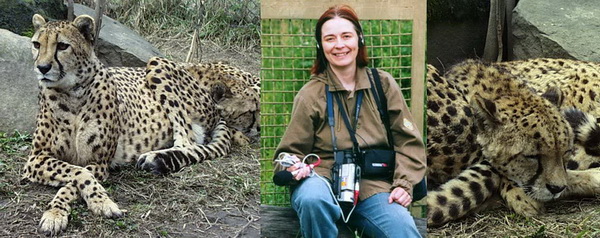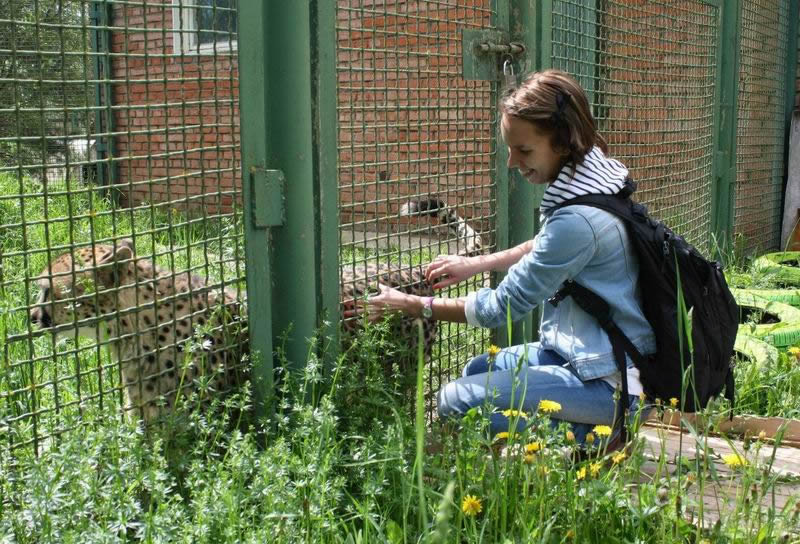|
|
|
CHEETAH (Acinonyx jubatus)

Study Site: Moscow Zoo and Volokolamsk breeding centre of Moscow Zoo (Moscow prov., Russia), Ecocenter "Djeiran" (Bukhara prov., Uzbekistan).
Dates: 1984 -1992, since 2013.
Participants: Volodina Elena.
Collaborators: Chelysheva Elena (Moscow Zoo, Russia)
Popular papers: <Science & Life>. |
|
If male and female cheetahs live together in one enclosure, they do not breed, becoming just friends. To receive cubs, zoo keepers should join a male and a female only for the time when a female is in estrus. However, the start of estrus can not be determined by female behaviour or sounds. It can be determined however… by specific chirr vocalizations of a male, when it sniffing the urine of a female in estrus. Moreover, a male remaining silent in response to the odor of the estral female, will not be successful as a breeder therefore joining it with a female is only wasted labor. Thus, the chirr vocalization indicates both the receptiveness of a female and the quality of a male. Mother cheetahs also produce chirrs, in the context of mother-offspring communication. In addition, vocalizations provide provide acoustic indicators of welfare in the cheetah, as they label confidence and diffidence of the animals, as well as aggressiveness and nonaggressiveness both in adult and young.
There were a few research focuses:
- To describe vocal repertoires in adult and young.
- To reveal acoustic indicators of female estrus and of potential of males to breed.
- To determine, what call types are affected by captivity.
- To reveal acoustic indicators of welfare in the cheetah in captivity. That is, call features, related to confidence, diffidence, aggressiveness, and non-aggressive, appeasing or submissive, behaviour.
  Sounds in the Gallery. Sounds in the Gallery.
|

|
|
Papers:
- Smirnova D.S., Volodin I.A., Demina T.S., Volodina E.V. Acoustic structure and contextual use of calls by captive male and female cheetahs (Acinonyx jubatus) // PLoS ONE, 2016, v. 11(6): e0158546. p. 1-20. 227.pdf
- Smirnova D.S., Demina T.S., Volodina E.V., Volodin I.A. The occurrence of different call types in different behavioural contexts in captive cheetahs (Acinonyx jubatus) // “Scientific researches in Zoological Parks”, Iss. 31, Moscow, 2015, p. 104-112. (available in Russian). 221.pdf
- Volodina E.V., Volodin I.A. Vocalizations as internal states indicators in mammals: A review // Current Biology Achievements (Uspekhi Sovremennoi Biologii), 2001, v. 121, N 2, p. 180-189. (available in Russian). 122.pdf
- Volodina E.V. Organization of vocal repertoire in the cheetah in captivity. Ph.D. Thesis Abstract, Moscow, 2000, 24 p. (available in Russian). 209.pdf
- Volodina E.V. Vocal repertoire of cheetah Acinonyx jubatus (Carnivora, Felidae) in captivity: sound structure and search for means of assessing the state of adult animals // Entomological Review, 2000, v. 80, suppl. 2, p. s368-s378. Translated from Zoologicheskii Zhuarnal, 2000, v. 79, N 7, p. 833-844. 305.pdf
- Volodina E.V., Volodin I.A. The apply of data pooling procedure for the captive cheetah sounds analysis. // In: “Scientific researches in Zoos”, Iss. 10, Moscow, 1998, p. 262-264. (available in Russian).
- Volodina E.V. Infantile features revealed from sound structure in the cheetah in captivity: keys to animals’ self-esteem as being strong or weak // “Scientific researches in Zoos”, Iss. 10, Moscow, 1998, p. 143-159. (available in Russian). 207.pdf
- Volodina E.V. Vocalization as an emotional indicator in the cheetah Acinonyx jubatus in captivity // In: “Scientific researches in Zoos”, Iss. 9, Moscow, 1997, p. 149-162.(available in Russian). 204.pdf
- Volodina E.V., Volodin I.A. Vocalizations associated with reproductive behaviour in rare Felidae species // In: “Scientific researches in Zoos”, Iss. 6, Moscow, 1996, p. 142-184. (available in Russian). 111.pdf
- Volodina E.V. Cheetahs vocalizations in a frustration-provoking situation of movements’ restraint in captivity // “Scientific researches in Zoos”, Iss. 4, Moscow, 1994, p. 70-77. (available in Russian). 201.pdf
- Volodina E.V. The apply of bioacoustical methods in management and breeding of the cheetah in captivity // “Scientific researches in Zoos”, Iss. 4, Moscow, 1994, p. 92-100. (available in Russian). 202.pdf
|
|

